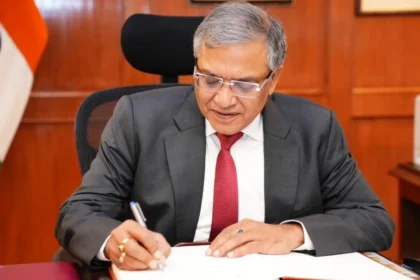The Pulse of the Market — Opening Bell to Midday Mood
Introduction: Why July 7, 2025, Matters
On July 7, 2025, financial markets across India opened with a mix of optimism and caution. Investors, brokers, and analysts braced themselves for a day dominated by geopolitical overhangs, trade policy anxiety, and domestic corporate action. Most notable was the impending tariff deadline set by U.S. President Donald Trump — a policy shift that could potentially alter the flow of capital and trade not only between the U.S. and China, but also across emerging economies like India.
The uncertainty surrounding this development, coupled with local IPO buzz and expectations from the India–US trade deal framework, created an environment charged with speculation and strategic repositioning. In short, it wasn’t just another Monday at Dalal Street.
The Opening Bell: First-Hour Volatility Explained
At 9:15 a.m., the Sensex opened at 76,285, marginally lower than Friday’s close, reflecting nervousness across key sectors like metals, IT, and consumer goods. Nifty followed suit, dipping 47 points within the first 15 minutes. However, this dip wasn’t a crash—it was a calibrated correction, the kind that signals smart money is waiting for clarity before making decisive bets.
Among the early movers:
- Infosys and Wipro saw a 1.5% dip as tech investors grew wary of tariff spillovers affecting outsourcing contracts.
- Larsen & Toubro (L&T) gained 2.3% after winning a ₹4,200 crore infrastructure contract from the Maharashtra government.
- Reliance Industries, the heavyweight, stayed flat—balancing oil price pressure with consumer segment gains.
Volume was strong in the opening hour, particularly in midcaps and IPO-linked counters, hinting at speculative activity from retail investors.
The Trump Effect: Tariff Deadlines and Indian Equity Jitters
One of the biggest factors driving market sentiment was the looming U.S. tariff deadline. President Trump had set July 7 as the final window for a decision on imposing 25% duties on select technology imports, affecting Asian suppliers across sectors.
While India was not directly targeted in the initial draft, the global interconnectedness of supply chains and dollar-linked portfolio flows meant any shock in U.S. trade policy would ripple through emerging markets.
Why does this matter for Indian equities?
- Export-oriented IT firms fear client pullbacks or renegotiation of multi-year contracts.
- Auto and Pharma exporters face indirect pressure due to logistics disruptions and cost inflation.
- FPIs (Foreign Portfolio Investors) tend to exit high-volatility zones ahead of global uncertainty, impacting liquidity and sentiment.
By 11:30 a.m., both Sensex and Nifty had recouped early losses, buoyed by clarity that any announcement from the White House might be “post-market”, giving traders breathing space.
India-US Trade Deal: What’s on the Table?
Simultaneously, behind closed doors in Delhi and Washington, officials were pushing for a bilateral trade framework between India and the United States. The deal—anticipated since early 2024—is expected to focus on:
- Pharmaceutical patent protection reforms
- Duty-free access for select U.S. agricultural goods
- Relaxation on India’s digital data localization norms
- Mutual recognition of certifications in tech and telecom
This has direct implications for several Indian listed firms:
- Sun Pharma, Dr. Reddy’s, and Lupin could gain from clearer export pathways.
- Agrochemical stocks like UPL and Rallis India would react to agri import clauses.
- Tech Mahindra and HCLTech stand to benefit from more open cross-border data policies.
Investors are pricing in optimism, but any trade-off that hurts domestic industry could backfire politically, especially with state elections looming in Maharashtra and Tamil Nadu.
IPO Buzz: Retail Euphoria vs. Institutional Caution
The IPO calendar for July is packed, and Monday was a key day for price discovery in several ongoing public issues. Notably:
- Ather Energy, the EV two-wheeler unicorn, opened its ₹6,800 crore IPO for subscription.
- Tata Technologies’ SME division made its listing debut, surging 58% within minutes.
Retail participation remains aggressive, especially in pre-IPO grey markets and in new-age tech ventures. But institutional response is more nuanced, with funds wary of overvaluation in a market already stretched by momentum buying.
The SEBI has also issued fresh guidelines on promoter lock-in periods, which might affect pricing strategies for some of these issues.
Sectoral Breakdown: Who’s Winning, Who’s Bleeding?
| Sector | Performance (% Change) | Key Drivers |
|---|---|---|
| Pharma | +1.8% | Trade deal hopes, global demand cues |
| IT Services | -0.9% | Tariff fears, cautious global outlook |
| Infrastructure | +2.2% | Govt capex, L&T contract announcement |
| FMCG | -0.5% | Profit booking after strong June rally |
| PSU Banks | +1.3% | Anticipation of recapitalization push |
Clearly, defensive sectors like pharma and infra are gaining favor, while high-beta IT and consumption are seeing mild corrections. The broader market remains stable, but stock selection is becoming critical as volatility rises.
Rupee, Crude, and Global Cues
As always, the macro mix matters.
- INR/USD hovered around ₹83.65, weakening mildly amid rising dollar index.
- Brent crude stayed above $86.2/bbl, driven by Middle East tensions and tighter supply.
- Global equity indices showed mixed trends, with Nikkei up 0.4% and Hang Seng down 1.1%.
Bond yields in India remained sticky around 7.05%, suggesting the market is not pricing in any immediate rate cut from the RBI, despite global dovish signals.
📝 Conclusion of Part 1: Positioning for Uncertainty
The first half of July 7, 2025, has shown that Indian markets are not immune to global tremors, but they are resilient enough to adapt. With institutional flows steady, corporate earnings approaching, and IPO euphoria still strong, the next move will depend on two questions:
- Will Trump’s tariff sword fall tonight?
- Can India clinch a favorable trade pact without compromising sovereignty?
As we enter the afternoon session, market participants are choosing tactical positioning over blind momentum, and that’s a sign of maturity in Indian capital markets.
The Midday Pulse: Tactical Rotation in Action
By the time the markets crossed the 1:30 PM mark on July 7, 2025, the trading pattern had shifted decisively. What began as a tentative and cautious morning had turned into a tug-of-war between bulls and bears, with intra-sector rotation driving volatility.
- Sensex hovered between 76,050 and 76,480 levels.
- Nifty was flat to mildly positive, refusing to commit to either breakout or breakdown.
- India VIX, the volatility index, rose by 4.5% intraday—signaling nervous energy ahead of the U.S. announcement.
The action was no longer broad-based. Investors were diving deep into theme-based trades—betting on India-US diplomacy, power sector reforms, and even niche commodities like rare-earth minerals.
Institutional Activity: Smart Money Takes the Wheel
As the retail frenzy cooled by midday, institutional investors began making their presence felt. Data from NSE’s provisional figures showed:
- Foreign Institutional Investors (FIIs) were net buyers to the tune of ₹1,130 crore.
- Domestic Institutional Investors (DIIs) booked profits worth ₹680 crore, largely from auto and FMCG.
Institutional behavior suggested a clear pattern:
- FIIs were accumulating capital goods and infra in anticipation of U.S. investment inflows.
- DIIs were cautious, preferring to book profits in defensives and redeploy post-announcement.
Mutual fund desks reported fresh SIP allocations targeting banking and pharma. Meanwhile, hedge funds, particularly from Singapore and the Gulf, were dabbling in high-beta names, often with options protection.
The Trump Curveball: Breaking News Hits Markets at 2:00 PM
At exactly 2:00 PM IST, a Bloomberg flash rattled terminals: “White House confirms new 18% tariff on select Chinese semiconductors; trade package to be discussed with India & Vietnam.”
This partial confirmation of a tariff hike—though not the 25% feared—was enough to send global equity indices swinging.
Impact on Indian markets:
- Nifty IT Index slid 0.7% in 20 minutes.
- Export-heavy firms like Dixon Technologies and Amber Enterprises turned negative.
- Gold prices spiked ₹540/10g, hitting ₹66,800 in the spot market.
Strikingly, India was mentioned as a possible beneficiary of trade realignment. This triggered a sectoral rotation toward Make-in-India stocks, including:
- BEL, HAL, Polycab, and Bharat Forge (defense and electronics manufacturing).
- Vedanta, Hindalco, and JSW Steel (commodity hedge and export substitutors).
IPO Frenzy in Full Swing: Retail Buys, Analyst Warnings
Despite the macro volatility, India’s IPO markets remained exuberant:
- Ather Energy IPO received 5.2x oversubscription by 3 PM on Day 1.
- Adani AgroTech’s FPO opened to lukewarm response but picked up steam post noon after brokerages issued a “Subscribe for Listing Gains” note.
Analysts cautioned:
“Retail investors are throwing darts hoping every IPO is a multi-bagger. That’s not sustainable in a high-volatility environment.”
SEBI’s data showed record participation from Tier 2 and 3 cities, where many first-time investors used fintech apps to apply. Many used UPI-autopay via popular brokers, with demand clustering around low-price bands.
The Currency Market Response: INR Struggles, RBI Intervenes
Currency markets bore the brunt of Trump’s move:
- The rupee dipped to ₹83.95/$, close to record lows.
- RBI was seen intervening at spot and futures levels to stem panic.
- Traders noted $1.2 billion of dollar selling by PSU banks, presumably on behalf of the central bank.
Bond markets stayed flat but dealers hinted at possible OMO (Open Market Operations) if rupee pressure continued. This would allow RBI to pump liquidity without cutting policy rates.
Gainers & Losers: Late-Session Movers
Top Gainers
- BEL: +4.7% (Defense play on US realignment)
- Polycab India: +3.2% (EV cable infra optimism)
- Bharat Forge: +2.9% (Make-in-India beneficiary)
Top Losers
- Infosys: -2.1% (Export risk exposure)
- Divi’s Labs: -1.4% (Patent pricing fears in trade talks)
- Asian Paints: -1.2% (Crude-related margin stress)
The standout trend? The emergence of “geo-economics investing”, where foreign policy narratives dictate price action more than quarterly numbers.
Market Sentiment Tracker: What Experts Are Saying
Motilal Oswal’s CIO:
“The afternoon sell-off was not panic; it was recalibration. We see value in capital goods, PSU banks, and agri-chemicals.”
Kotak Securities’ Technical Desk:
“Nifty has strong support at 22,460 and resistance at 22,770. A breach either side post-U.S. close could decide trend.”
Nomura India Strategist:
“Trump’s tariffs will divide emerging markets into winners and losers. India’s reaction will depend on how well it negotiates trade-offs.”
Domestic Developments: India’s Own Headlines Amid Global Noise
Even as global headlines dominated, local stories remained impactful:
- GST collections for June hit ₹1.78 lakh crore, a 7% YoY rise.
- The Centre announced a new solar PLI scheme worth ₹18,000 crore, benefiting renewable energy stocks.
- TCS announced an ₹18,000 crore buyback plan, boosting investor confidence in large-cap IT.
These signals of macro stability and reform continuity helped cushion the market from external jolts.
All Eyes on the Closing Bell and Wall Street’s Response
As the markets braced for the final hour of trade, the tone was one of guarded optimism. Trump’s move was softer than expected, and India’s inclusion in trade realignment talks gave Dalal Street a reason to hope.
The IPO boom continued to defy volatility, but institutions were already shifting gears to protect capital.
As the sun set over Dalal Street, attention turned westward—to how Wall Street would react when it opens. Would U.S. tech sell off? Would Nasdaq tank? Or would global investors cheer a policy reset?
Wall Street Awakens: The First 60 Minutes
At 6:00 PM IST, U.S. markets rang the opening bell. Within the first hour, traders in Mumbai, Singapore, and Dubai were glued to their screens.
Here’s what happened:
- Dow Jones opened 182 points lower, weighed down by fresh tariffs and weak manufacturing data.
- Nasdaq Composite saw a steep intraday drop of 1.6%, led by chipmakers and AI stocks exposed to Chinese trade.
- S&P 500 showed resilience initially but began fading by 7 PM IST.
Tech stocks bled red:
- NVIDIA: -3.5%
- AMD: -2.9%
- Apple: -1.7%
- Tesla: -4.2% (hit by China exposure and regulatory overhang)
The sentiment: “Tariff tremors had arrived.”
Investors had expected aggressive retaliation from China—which, as per rumors, was considering rare-earth mineral export curbs and restrictions on U.S. cloud computing services operating on Chinese infrastructure.
India ADR Watch: Offshore Clues for NSE and BSE
India-focused ETFs and ADRs on the NYSE became real-time sentiment meters for Dalal Street’s next move:
- Infosys ADR dropped 2.1%, mirroring Nasdaq.
- Wipro ADR followed with a 1.9% decline.
- ICICI Bank ADR held ground, only down 0.3%, indicating relative domestic strength.
The iShares India ETF (INDA) saw net inflows of $18.7 million, suggesting that foreign investors were still betting on India’s trade neutrality amid the U.S.-China dust storm.
SGX Nifty Futures Drift: After-Hours India Sentiment
The SGX Nifty (now GIFT Nifty) became the final battlefield of the day for India bulls and bears.
- At 7:30 PM IST, it was down 72 points, indicating a negative bias for next day’s open.
- Heavy volume at the 22,450 strike put options indicated that traders were hedging for downside.
However, institutional desks remained divided:
- Bull case: India is a neutral partner in the U.S.-China conflict, with supply chain wins ahead.
- Bear case: Any escalation could impact global liquidity, which in turn affects EMs.
Hedge funds in Singapore reported selling high-beta Indian banks and tech while buying PSU stocks and defensive pharma.
After-Hours Earnings Buzz: Domestic Impact Plays
Several companies dropped Q1FY26 earnings updates post-market:
- Tata Elxsi: Reported a 17.2% YoY profit growth; strong commentary on autonomous vehicle software deals with U.S. clients.
- Bharti Airtel: Margins dipped slightly, but ARPU (Average Revenue Per User) hit an all-time high at ₹219.
- Glenmark Pharma: Missed street estimates; U.S. generics pricing pressure cited.
These results prompted re-ratings in post-market reports, and analysts expected Tata Elxsi to open gap-up, while Glenmark could face sell pressure.
Expert Takes: Voices from Wall Street & Dalal Street
Goldman Sachs – India Note:
“India remains a structurally positive EM story, but short-term volatility is inevitable. Reforms like PLI, ONDC, and semiconductor subsidies offer tailwinds.”
JP Morgan Asia Strategist:
“U.S.-China tariffs will shift capital and supply chains. India, Indonesia, and Vietnam are first-order beneficiaries.”
Kotak Institutional Equities:
“We advise adding quality midcaps in power, logistics, and defense on dips.”
Zerodha’s CEO Nithin Kamath (on X):
“Retail investors are now more informed but also more reactive. Learning to ride volatility will define the next generation of India’s equity culture.”
Global Market Summary Snapshot (as of 9:00 PM IST)
| Index | Movement | Remarks |
|---|---|---|
| Dow Jones | -185 pts | Defensive buying into close |
| Nasdaq | -1.7% | Tech exposed to China hit hard |
| FTSE 100 | +0.3% | Energy stocks lifted market |
| DAX | -0.6% | Weak German industrial data |
| SGX Nifty (GIFT) | -72 pts | Indicates cautious India open |
| Crude Oil (Brent) | $83.2/bbl | Steady after Iran shipping news |
| Gold (Spot) | $2,420/oz | Near record highs |
| INR/USD | ₹83.91/$ | Under RBI watch, mild depreciation |
Social Media & Retail Sentiment: The Retailers React
The Twitter/Reddit trading communities in India buzzed post-8 PM with mixed signals:
- #TariffTrouble trended with over 60,000 tweets.
- Retail Telegram groups debated shifting focus to safe havens like ITC, Coal India, and BEL.
- Finfluencers shared “overnight watchlists,” many loaded with PSU names.
Several influencers warned:
“Avoid FOMO on breakout charts unless macro aligns. Respect volatility. Protect capital first.”
Apps like Smallcase, Groww, and Dhan saw a rush in sector rotation portfolios, especially defense, railways, and agri-tech.
What to Expect Tomorrow: Technical Zones, News Triggers
Technical Outlook for July 8, 2025
| Index | Support | Resistance | Bias |
|---|---|---|---|
| Nifty | 22,440–22,480 | 22,770–22,820 | Cautious Bullish |
| Sensex | 76,100 | 76,700 | Range-Bound |
Key Triggers to Watch
- U.S. Fed Chair Jerome Powell’s statement on inflation trajectory.
- China’s retaliation plan on semiconductor tariffs.
- India’s own IIP (Index of Industrial Production) and inflation preview.
- Final IPO subscriptions for Ather Energy and Adani AgroTech.
Closing Bell Reflection: What the Day Taught Traders
- Geo-economics is the new macro. India is increasingly reacting not just to domestic indicators but to its place in global power corridors.
- Retail is maturing. Many small investors held onto SIPs and avoided panic selling.
- Volatility ≠ chaos, if you’re prepared. Tools like GIFT Nifty, SGX futures, ADRs, and after-market guidance are making Indian markets globally synchronized.
Also Read : India’s 2025 Digital Census: 140 Crore Citizens Can Now Self-Ennumerate Online for the First Time







